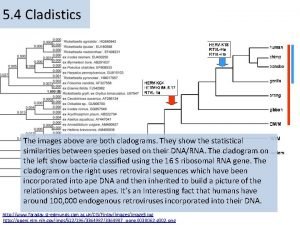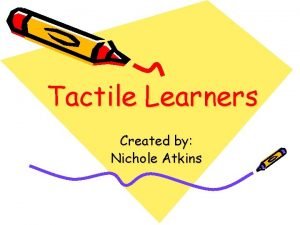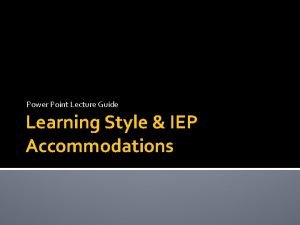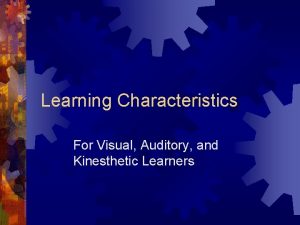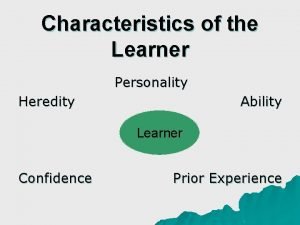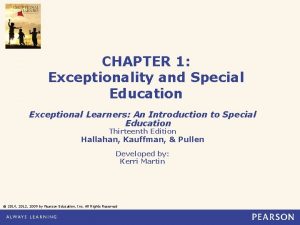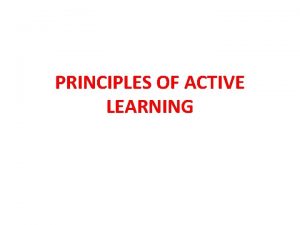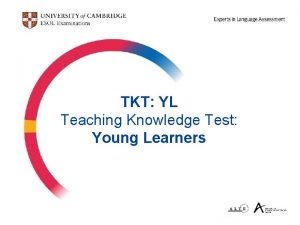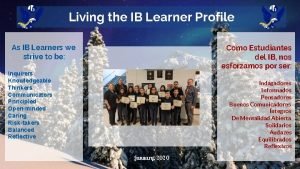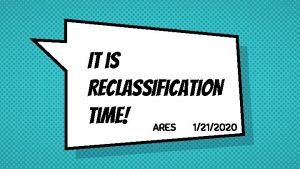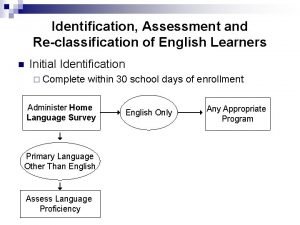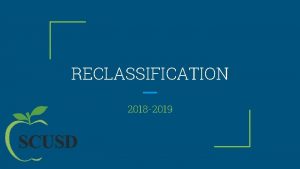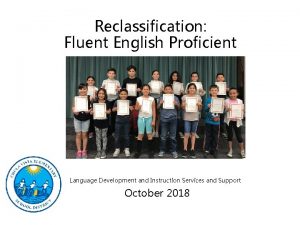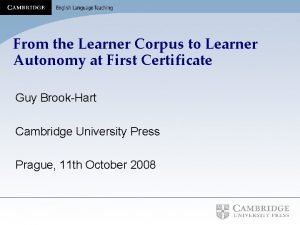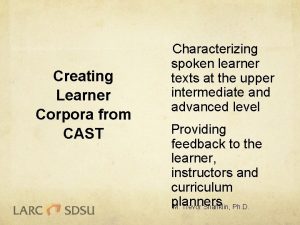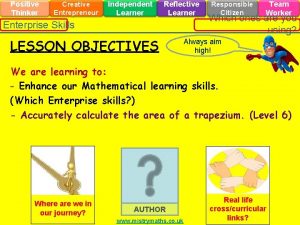ENGLISH LEARNER SERIES RECLASSIFICATION OF ENGLISH LEARNERS IN





































- Slides: 37

ENGLISH LEARNER SERIES: RECLASSIFICATION OF ENGLISH LEARNERS IN SPECIAL EDUCATION OCTOBER 4, 2018 JOANNA V. DELLA GATTA, DIRECTOR YANKA RICKLEFS, DIRECTOR VENTURA COUNTY SELPA

OBJECTIVES • Who is involved? • When to consider recommending reclassification • Completing the worksheet for recommendation

LEA RECLASSIFICATION CRITERIA FOR ALL STUDENTS Reclassification: defined as the process by which ELs are RFEP when they have demonstrated they can compete effectively with their English-speaking peers, CBE/CDE per EC 313 (d) 1)Assessment of English language proficiency (ELP) using an objective assessment (including, but not limited to the state test ELPAC/CELDT) and 2)Teacher evaluation, including but not limited to a review of the student’s mastery of the curriculum and 3)Comparison of performance in basic skills based on the performance of English proficient students of the same age and 4)Parent opinion/consultation CDE Letter dated 9_14_18 Reclass Guidance 18 -19

REASONS STUDENTS WITH DISABILITIES DO NOT MEET DISTRICT REQUIREMENTS English language proficiency (ELP) assessment • Do not meet minimum scores Basic Skills comparison (SBAC or local assessments determined by LEA) • Do not meet proficiency on ELA Classroom performance • Do not perform at grade level in curriculum based assessments

WHY USE ALTERNATE CRITERIA? Allows a team that knows the student to make the connection that the failure to meet the district reclassification criteria is a result of the disability, not second language acquisition

In preparation for an IEP meeting WHEN TO DISCUSS RECLASSIFICATION? May be done at Other Review or Addendum At the IEP meeting. Ideally at an Annual Review or Triennial Review

Parents WHO IS INVOLVED IN THE PROCESS? Site EL Teacher on Special Assignment (TOSA) or General Ed. ELD teacher or the Language Acquisition Team member, EL Coordinator LEA Representative Case Manager, School Psychologist, Speech Language Pathologist

HOW TO GET STARTED? 1) Consult with EL Coordinator 2) Use Reclassification worksheet and look at the sources of data that you will need: • Past two years’ scores on CELDT/ELPAC or VCCALPS • If VCCALPS, performance in native language • Classroom-based assessments (CBMs, district assessments, functional skills data collection) • Most recent scores in ELA from CAASPP or local assessment of basic ELA skills • Performance in English at home and in community (use of English in home on phone, watching television and communication in the community)

DEVELOP A PROCESS FOR RECLASSIFICATION For students with disabilities, each district will: 1) Compile a list of students who have not met the LEA overall reclassification criteria. 2) The IEP team meets and includes the district/site EL personnel and consults with parents. 3) Consider whether the disability is impacting performance. 4) If the IEP team determines that the primary reason the student does not meet LEA reclassification criteria is due to the disability rather than limited English proficiency and the student no longer needs English learner services, they will recommend reclassification and send the information to the EL reclassification district representative. 5) Case manager and parent are notified, student is given an RFEP date and the next IEP will reflect the change in status.

STEP 1 - WHO? Compile a list of students with IEPs who have not met the overall reclassification criteria. How would you go about this task? Who has this information?

STEP 2 - CONSULT AS A TEAM The stakeholders meet. Be sure to include the district/site EL personnel and consult with parents.

STEP 3 - USE RECLASSIFICATION WORKSHEET Consider whether the disability is impacting performance. Use the CDE criteria for reclassification of all students with considerations for students with disabilities.

BEGIN WITH YOUR EXPLANATION OF HOW THE DISABILITY AFFECTS LANGUAGE ACQUISITION

CLASSROOM MEASURES OF PERFORMANCE • Show image of top part of page 2

WORKSHEET FOR IEP TEAM RECOMMENDATIONS FOR RECLASSIFICATION 1) Assessment of English Language Proficiency: CELDT/ELPAC or alternate (VCCALPS). If the regular criteria are not met, IEP team considers the impact of the disability on the scores and determines whether the student demonstrates English Language Proficiency commensurate with abilities. Possible indicators: • Student has similar academic deficits and error patterns in English as well as primary language • error patterns in listening, speaking, reading, and writing are typical of students with that disability versus students with developing second language • VCCALPS scores indicate overall proficiency level of Bridging

1. ENGLISH LANGUAGE PROFICIENCY ASSESSMENT • Enter most recent scores onto the worksheet • If the student DID NOT meet minimum scores in language proficiency, go to the second half of the section.

PERFORMANCE ON EL TEST • Show image of bottom half of page one

ALTERNATE MEASURES FOR ESTABLISHING LANGUAGE PROFICIENCY 1 Enter last year’s scores 2 Enter native language scores if you have them (e. g. , VCCALPS or Bateria Woodcock) 3 Indicate the reason student did not meet minimum scores on ELPAC/ CELDT or VCCALPS: • Other informal measures indicate they are “likely proficient” in English • Disability affects performance on tests 4 Check the bottom box “yes” and move to the next section

PERFORMANCE ON EL TEST • Show image of bottom half of page one

2. TEACHER’S EVALUATION OF ACADEMIC PERFORMANCE • Review CBMs, district-wide assessment, formative assessment, progress on IEP goals. • Compare to peers with like disabilities. A disability may be a factor that contributes to low achievement and unrelated to English language proficiency. • If the regular criteria are not met, the IEP team considers the impact of the disability on academic performance and determines whether the student demonstrates a level commensurate with abilities, rather than acquisition of English. • Give rationale • Check the bottom “yes” box and move to the next section

TOP OF FORM • Show graphic of top of form and what goes on it (demographics, etc? )

WORKSHEET FOR IEP TEAM RECOMMENDATIONS FOR RECLASSIFICATION 3) Comparison of Basic Skills: SBAC, CAA, local assessments. If the regular criteria are not met, IEP team considers the impact of the disability on English/Language Arts/Literacy and determines whether the student demonstrates ELA basic skills commensurate with abilities. 4) Parent Opinion and Consultation: parent participation in the process and comments are noted Recommendation: The IEP determines whether the primary reason the student does not meet reclassification criteria is due to the disability rather than limited English proficiency and the student no longer needs ELD services.

3. COMPARISON OF PERFORMANCE IN BASIC SKILLS • Scores on SBAC or CAA- ELA • Make the case that the low performance in ELA is due to the disability, not the acquisition of English • Check the bottom box ”yes” and move on to the next section


4. PARENT INPUT • Parents must have input in the process, but don’t have to agree • Work with your EL TOSA/District Bilingual Director/EL Coordinator about what to do if parent is not in agreement • Document parent input

TOP OF FORM • Show graphic of top of form and what goes on it (demographics, etc? )

TEAM DETERMINATION • Check “yes” at the bottom of the page. • Enter in names of staff who participated in the process • Requires: • Special Ed Case Manager/School Psychologist • EL Expert • LEA Representative

CONSULTATION BY EL SPECIALIST • Show bottom part of page 3

ELD page: IF THE TEAM AGREES TO RECLASSIFY AT THE MEETING • Put in scores at top as usual • Check the box: “The IEP Team agrees to recommend the student for reclassification…” • Keep the bottom half of the form BLANK • No Goal numbers or services Present Levels page: Describe progress in reading, writing, communciation Notes page: summarizes reclassification SIS page: will say “EL”


STEP 4 - AFTER THE WORKSHEET IS COMPLETE If the team determines that the primary reason the student does not meet reclassification criteria is due to the disability rather than limited English proficiency and the student no longer needs English learner services, they will recommend reclassification and send the information to the EL reclassification district representative.

STEP 5 RECLASSIFICATION Case manager and parent are notified, student is given an RFEP date and the next IEP will reflect the change in status.

SCENARIO Jorge is an 8 th grade student eligible for special education under specific learning disability. He is a highly verbal student who struggles in the areas of reading and writing due to a visual processing deficit. He functions at approximately the 7 th grade level in math and the 4 th-5 th grade level for reading and writing. He was classified as an English Learner upon entering kindergarten. His ELPAC scores this year are: • • Overall: Moderately Developed- Level 3 Oral Language: Moderately Developed- Level 3 Written Language: Somewhat Developed- Level 2 Listening: Moderately Developed Speaking: Somewhat Developed Reading: Minimally Developed Writing: Beginning

CONSIDER RECLASSIFICATION; PRACTICE WITH A PARTNER

Is the reclassification worksheet used for Mild/Moderate AND Moderate/Severe students? QUESTIONS Who can reclassify? What is the IEP team’s role in recommending reclassification?

RESOURCES • CDE website: Testing and Accountability & Specialized Programs • 2016 -2017 and 2017 -2018 CELDT Information Guide • CDE Letter Interim Reclassification Guidance for 2017– 18, dated January 2, 2018 • Matrix Four (2017) for ELPAC • Ventura County SELPA Website (www. vcselpa. org): Resources for Teachers and Staff/English Learners • Guidelines for Reclassification of English Learners with Disabilities, Ventura County SELPA (2016) • Ventura County Comprehensive Alternate Language Proficiency Survey (VCCALPS), Ventura County SELPA (2018) • Meeting the Needs of English Learners with Disabilities, Santa Barbara County SELPA (2016)

 Figwort reclassification
Figwort reclassification Lazy vs eager
Lazy vs eager Language tools
Language tools English language learners
English language learners Teaching young learners english
Teaching young learners english Reading strategies for english language learners
Reading strategies for english language learners Equal protection for english language learners
Equal protection for english language learners Maclaurin series vs taylor series
Maclaurin series vs taylor series Heisenberg 1925 paper
Heisenberg 1925 paper Maclaurin expansion
Maclaurin expansion Taylor series lesson
Taylor series lesson Ibm p series
Ibm p series Shunt-series feedback
Shunt-series feedback Series aiding and series opposing
Series aiding and series opposing Arithmetic sequence formula
Arithmetic sequence formula Global vs analytical learners
Global vs analytical learners How to teach grammar to young learners
How to teach grammar to young learners Heather nichole atkins
Heather nichole atkins Remedial teacher meaning
Remedial teacher meaning Global vs analytical learners
Global vs analytical learners Characteristics of a kinesthetic learner
Characteristics of a kinesthetic learner Facts about tactile learners
Facts about tactile learners When is cognitivism beneficial for learners
When is cognitivism beneficial for learners Visual iconic learners
Visual iconic learners Article 10 the teacher and business
Article 10 the teacher and business Characteristic of learners
Characteristic of learners Exceptional learners: an introduction to special education
Exceptional learners: an introduction to special education Active learning principles
Active learning principles Young learners characteristics
Young learners characteristics 3b using questioning and discussion techniques
3b using questioning and discussion techniques Background information for learners
Background information for learners Rigor and relevance quadrants
Rigor and relevance quadrants Deped gifted and talented program
Deped gifted and talented program Celebrities with naturalist intelligence
Celebrities with naturalist intelligence The learners will be able to
The learners will be able to Tkt yl
Tkt yl Graham nuttall the hidden lives of learners
Graham nuttall the hidden lives of learners Ib learner profile inquirer
Ib learner profile inquirer
